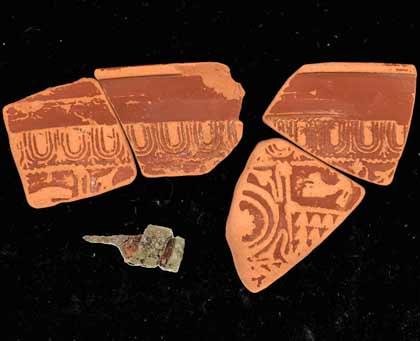Skeletons reveal British capital's 2,000-year history as ethnic melting pot
Ben Miller
Source - http://www.culture24.org.uk/history-and-heritage/archaeology/art541900-museum-london-roman-archaeology-dna-harper
Four Roman Londonders carried links to Europe, Africa and Eurasia, suggests most detailed DNA picture ever put together from the period
 This Roman woman was buried with high status grave goods and discovered at Harper Road. She was found to have male chromosomes, although experts say her skeleton shows clear female characteristics © Museum of London
This Roman woman was buried with high status grave goods and discovered at Harper Road. She was found to have male chromosomes, although experts say her skeleton shows clear female characteristics © Museum of London
Detailed DNA analysis of four Roman Londoners shows a female with male chromosomes, a man who may have been murdered in an amphitheatre before his head was dumped into a pit and a common affliction of periodontal disease among the quartet of skeletons, say Museum of London experts releasing research findings on the bodies for the first time.
In the most comprehensive picture of Londinium residents to date, a man discovered at London Wall, possessing black hair and dark brown eyes, is said to have been born outside of Britain – his mitochondrial data holds connections to eastern Europe and the Near East. The man carries injuries to his skull consistent with a gruesome death.
Grave goods – an important part of the archaeological evidence – were found with a woman buried at Harper Road. Her skeleton shows “clear female characteristics”, although her male chromosomes are being taken as signs of the “spectrum” of biological sex established by modern scientific theories.
While the Harper Road burial has dark hair, brown eyes and links to northern Europe, a teenage girl at Lant Street has a maternal line leading to south-eastern Europe and west Eurasia, giving her blue eyes.
Stable isotope results show that she was born in north Africa, where a second man, discovered at Mansell Street and suffering from two rare conditions - Paget’s disease and Diffuse Idiopathic Skeletal Hyperostosis - could also have been born.
“We have always understood that Roman London was a culturally diverse place,” says Caroline McDonald, a Senior Curator on the team carrying out the first multidisciplinary study of the inhabitants of a city anywhere in the Roman Empire.
“Now science is giving us certainty. People born in Londinium lived alongside people from across the Roman Empire exchanging ideas and cultures, much like the London we know today.”
Isotopes from the skeletons’ tooth enamel were examined by University of Durham experts who provided conclusions on their migration paths. A further tooth from each body was sent to McMaster University, in Canada, for a DNA analysis, establishing their hair and eye colour, chromosomal sex, diseases and maternal ancestry.
“This small study of four Roman skeletons is just the start,” says Sharon Ament, the Director of the museum.
“As we look to the possibility of a new Museum of London in West Smithfield, scientific research which stretches thinking about London and Londoners will underpin the stories we tell.”
A small display outlining the findings, Written in Bone, will open at the museum on Friday (November 27 2015). The collection already contains the remains of almost 20,000 Londoners.